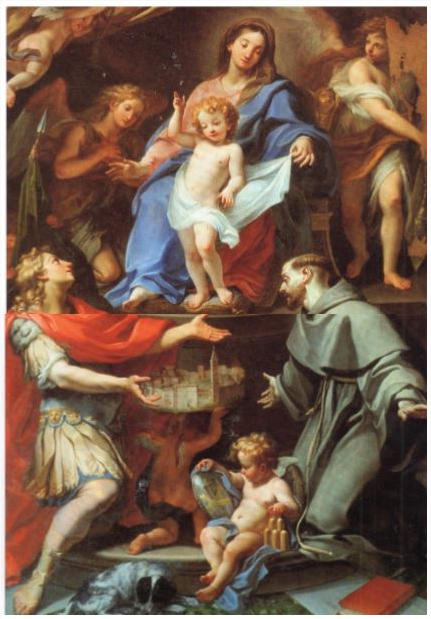Marco Benefial (1684-1764)
Il dipinto è collocato nella parte destra del transetto, a sinistra in alto.
Insieme alla Vergine e al Bambino, nella parte inferiore, si possono vedere S. Francesco ed il Patrono San Vito che regge un’altra importante immagine del castello in una configurazione attribuibile agli inizi ‘700.
La tela viene attribuita al pittore romano Marco Benefial e la probabile provenienza del dipinto, per la presenza di San Francesco che indossa il saio dei frati conventuali, è la Chiesa Francescana di Santa Maria delle Grazie. Il bozzetto dell’autore delle dimensioni 33 cm X 47 cm è esposto al Museo del Louvre di Parigi.
Nella miniatura manca la Chiesa Collegiata, ancora da edificare, che avrebbe dovuto sostituire la vecchia chiesa cinquecentesca resa pericolante dal terremoto del 1741. Per questo motivo l’area interna viene rappresentata vuota.
Il putto seduto alla base del dipinto con una mano tiene i sei colli d’oro presenti nello stemma di Monte San Vito. Monte San Vito,poiché era stato dichiarato terra imperiale nella seconda metà del XII secolo, è rappresentato dal colle più alto che dominava sugli altri colli limitrofi. L’altra mano regge lo stemma dei committenti dell’opera, l’ordine dei francescani.
Blessed Virgin with Baby Jesus by Marco Benefial (1684-1764)
The painting is located on the right side of the transept, top left. Together with the Virgin and the Baby, in the lower part, you can see S. Francisco and the patron, Saint Vitus who’s holding another important picture of the castle, probably dating back to the early eighteenth century. The canvas, attributed to the Roman painter Marco Benefial, probably comes from the Franciscan church of Santa Maria delle Grazie considering the presence of Saint Francis wearing the habits of the Franciscans.
The sketch of the author, size 33×47, is exhibited at the Louvre Museum. The miniature lacks of the Collegiate Church, still to be built, which was to replace the old sixteenth church made unsafe by the earthquake of 1741. For this reason, the inside area is represented empty.
The Cherub, sitting at the base of the painting, holds with his hand the six gold hills depicted in the coat of arms of Monte San Vito. Monte San Vito, being declared imperial territory in the mid-12th century, is represented by the highest hill dominating the other neighbouring hills. With the other hand, the Cherub, holds the coat of arms of the work clients, the order of the Franciscans.


0